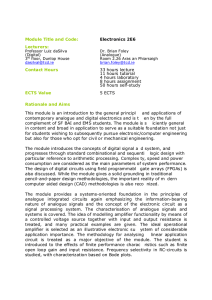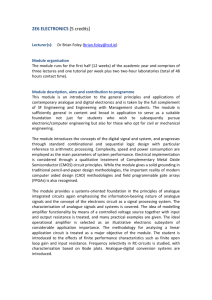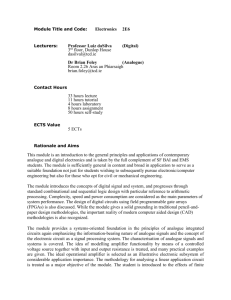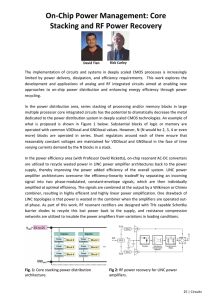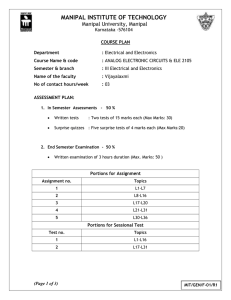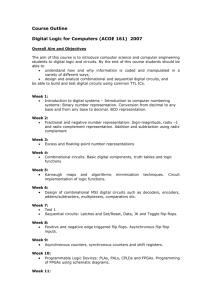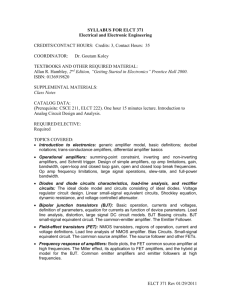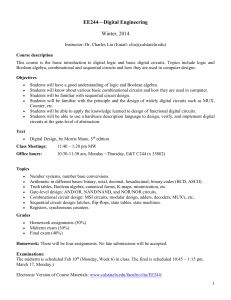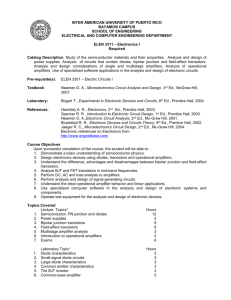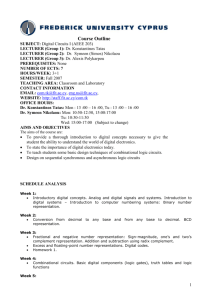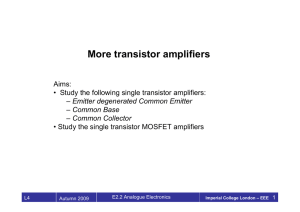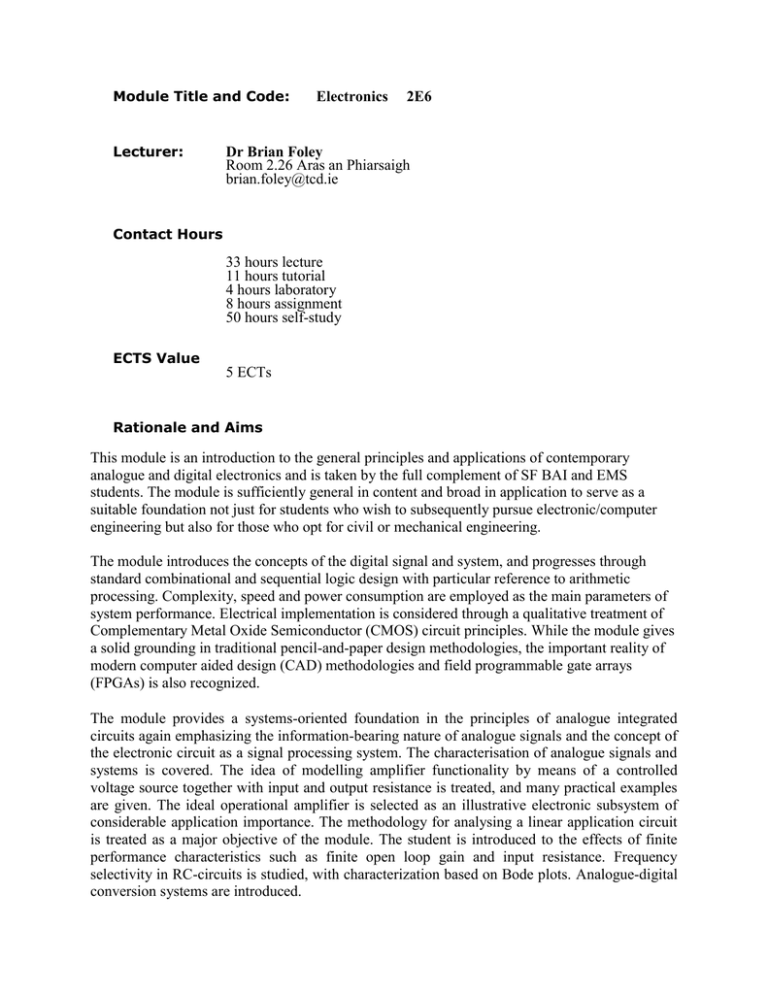
Module Title and Code:
Lecturer:
Electronics
2E6
Dr Brian Foley
Room 2.26 Aras an Phiarsaigh
brian.foley@tcd.ie
Contact Hours
33 hours lecture
11 hours tutorial
4 hours laboratory
8 hours assignment
50 hours self-study
ECTS Value
5 ECTs
Rationale and Aims
This module is an introduction to the general principles and applications of contemporary
analogue and digital electronics and is taken by the full complement of SF BAI and EMS
students. The module is sufficiently general in content and broad in application to serve as a
suitable foundation not just for students who wish to subsequently pursue electronic/computer
engineering but also for those who opt for civil or mechanical engineering.
The module introduces the concepts of the digital signal and system, and progresses through
standard combinational and sequential logic design with particular reference to arithmetic
processing. Complexity, speed and power consumption are employed as the main parameters of
system performance. Electrical implementation is considered through a qualitative treatment of
Complementary Metal Oxide Semiconductor (CMOS) circuit principles. While the module gives
a solid grounding in traditional pencil-and-paper design methodologies, the important reality of
modern computer aided design (CAD) methodologies and field programmable gate arrays
(FPGAs) is also recognized.
The module provides a systems-oriented foundation in the principles of analogue integrated
circuits again emphasizing the information-bearing nature of analogue signals and the concept of
the electronic circuit as a signal processing system. The characterisation of analogue signals and
systems is covered. The idea of modelling amplifier functionality by means of a controlled
voltage source together with input and output resistance is treated, and many practical examples
are given. The ideal operational amplifier is selected as an illustrative electronic subsystem of
considerable application importance. The methodology for analysing a linear application circuit
is treated as a major objective of the module. The student is introduced to the effects of finite
performance characteristics such as finite open loop gain and input resistance. Frequency
selectivity in RC-circuits is studied, with characterization based on Bode plots. Analogue-digital
conversion systems are introduced.
Course Content
Digital Systems and Binary Numbers
Digital signals and systems
Number systems
Positive/negative representation
Binary arithmetic
Boolean Algebra
Definitions and basic theorems
Algebraic simplification
Sum of products and product of sums formulations
Gate primitives
Karnaugh maps
Combinational Logic
Combinational design
Assessment of complexity and speed
Code converters, multiplexors, decoders
Addition circuits, priority encoder
Sequential Logic
Bistable latch, master-slave and edge-triggered flip-flops
Asychronous and synchronous counter design
Registers and shift registers
Digital Circuits
n- and p-channel MOS transistors
CMOS inverter, NAND, and NOR gates
General CMOS logic
Characterisation of Analogue Electronic Signals and Systems
Signals and electronic signal processing
dc and rms calculations
Resistive circuit analysis review and the Maximum Power Transfer Theorem
Thevenin theorem, Superposition Principle, and maximum power transfer
Signal transmission through linear and non-linear systams
Amplifiers and their Equivalent Circuits
Equivalent circuit of ideal and real amplifiers
Cascades of amplifiers
Frequency Response
Decibel notation
Classification of filters
RC-circuits and their Bode characterization
Operational Amplifier Circuits
The ideal operational amplifier
The inverting, non-inverting, differential and integrating configurations
Effect of finite open loop gain and input resistance
Introduction to analogue-digital conversion systems
Indicative Resources
Recommended Texts
MM Mano and MD Ciletti, Digital Design, 4th edition, (Pearson) Prentice Hall, 2007.
N Storey, Electronics: A Systems Approach, 4th edition, (Pearson) Prentice Hall, 2009.
Supplementary Reading
John F Wakerly, Digital Design: Principles and Practices, 3rd edition, (Pearson) Prentice Hall,
2000.
Donald D Givone, Digital Principles and Design, McGraw-Hill, 2003.
http://ocw.mit.edu/OcwWeb/Electrical-Engineering-and-Computer-Science/6-004ComputationStructuresFall2002/CourseHome/index.htm this is a pointer to the webmaterial of a roughly
equivalent digital foundation course at Massachusetts Institute of Technology.
http://eeclass.stanford.edu/ee108a this a pointer to a basic digital course at Stanford
University; under “General Handouts” you can find a link to a comprehensive course reader.
A S Sedra and K D Smith, Microelectronic Circuits, 5th edition, Oxford University Press, 2004.
G Clayton and S Winder, Operational Amplifiers, 5th edition, Newnes, 2003.
Background Reading
G Polya, How to Solve It, 2nd edition, Princeton University Press and Penguin, 1957
John D Cressler, Silicon Earth: introduction to the microelectronics and nanotechnology
revolution, Cambridge University Press, 2009.
Learning Outcomes
On successful completion of this module the student should be able to:
Convert between binary and decimal representations and carry out binary addition,
subtraction and multiplication;
Manipulate Boolean expressions so as to minimise the number of literals using algebra or
Karnaugh maps;
Design standard and iterative combinational logic circuits;
Evaluate the complexity and speed of combinational designs;
Explain the operation of basic sequential elements latch, master-slave flip-flop, edgetriggered flip-flop, and analyse simple sequential circuits such as counters and sequence
generators;
Describe the operation and determine the logic function of basic CMOS gate circuits.
Describe the concept of an information-bearing electrical signal, calculate the average
and root mean square values of regular periodic signals and carry out power calculations
given the frequency content;
Determine the output of simple linear and non-linear systems for given inputs;
Design and analyse source-amplifier-load configurations to meet given specifications;
Characterise and plot the frequency response of first-order RC-circuits;
Characterise the properties of the ideal operational amplifier; calculate the closed loop
gain and carry out design manipulations for basic linear operational amplifier
applications including the effects of finite open loop gain and first-order frequency
response;
Explain the operation of basic analogue-to-digital and digital-to-analogue converters.
Carry out basic experimental test procedures, record the results and write a laboratory
report.
Methods of Teaching and Student Learning
This module is formally delivered through a combination of lectures and tutorials, with two
supporting practical laboratory sessions. The tutorial sessions are based on problem solving
exercises with trained tutorial assistance available to provide guidance and feedback to the
students.
Some of the core module material is documented in a set of notes which is provided via the web
and in advance to all students. This core material incorporates not just the concepts and
methodologies, but also worked illustrative problems. Tutorial problem sheets and solutions are
also provided. Students are expected to read through the material in advance so that lecture time
can be allocated to
o explaining carefully the more difficult concepts and derivations;
o illustrating the material with sample problems and applications of wide interest;
o responding to student questions and inviting student input to choice of analysis strategy,
etc;
o setting short but focussed class-time problems.
From the point of view of teaching and learning strategy, the delivery approach would be
characterised by
o endeavouring to ensure that each session, lecture or tutorial, is an active learning
experience for the student;
o keeping the formal presentation and associated activities varied so that the experience,
while challenging, is also enjoyable;
o in principle following a “constructivist” philosophy, the idea being to get the students to
themselves construct as much of the new material as possible from what they already
know.
The basic module materials are provided in electronic form and care is taken to ensure that all
materials are both accessible to and usable by all students.
Methods of Assessment
85% of the mark returned for 2E6 is derived from a two-hour examination held at the end of the
academic year. The examination paper is divided into two sections (digital and analogue) each
comprising three questions. In answering four questions out of six, students are required to
answer two questions from each section. The remaining 15% of the marks are derived from a
laboratory programme of two experiments. A portion of the 85% examination mark may be
based on allocated assigned work.
Student progress will be monitored through their participation and performance at the tutorial
sessions. Feedback will be provided both by the lecturer and/or the module teaching assistants.
Evaluation
The lecturer is committed to participation in the gathering of student evaluation data and
comment by CAPSL, and in acting on that feedback as appropriate.

